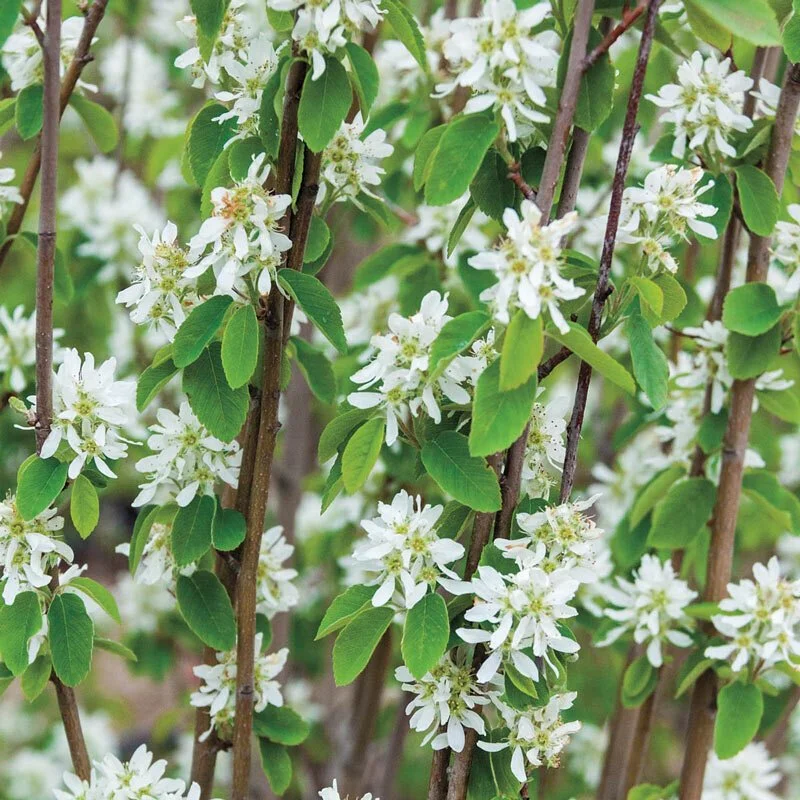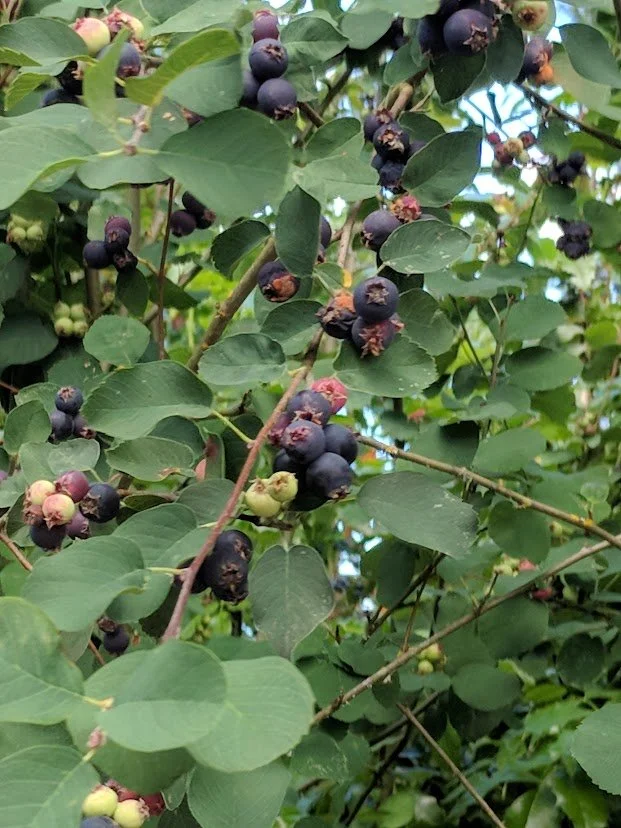Amelanchier alnifolia (Western Serviceberry)
Western Serviceberry is a great wildlife magnet! A native deciduous shrub/tree, it grows from 6-20 ft. tall, branching widely. It may take the form of a narrow tree or ultimately produce numerous shoots to become a broad shrub—it all depends on its growing conditions and the other plants it’s competing with.
Serviceberry grows best in full to part sun, well drained soils and moist or dry conditions, but it is also shade tolerant. It will be fully drought tolerant after one or two summers of intermittent supplemental water.
It has attractive dark bluish-green foliage and showy white flower clusters in the spring—great for pollinators. Purple fruits are produced in June and July, which are great for pies and jams or just eating fresh (or leave them to bring hordes of songbirds)! It is occasionally subject to a rust that turns the berries and some leaves orange, but this does not harm the plant and seems to attract more Cedar Waxwings to enjoy the berries.
This is one of the most versatile of our native shrubs, at home as a specimen or as an understory species. It is perfect for just about any landscape, and wonderfully suited to mixed-species hedgerows as it does not mind a little congestion from other shrubs.
Western Serviceberry is a great wildlife magnet! A native deciduous shrub/tree, it grows from 6-20 ft. tall, branching widely. It may take the form of a narrow tree or ultimately produce numerous shoots to become a broad shrub—it all depends on its growing conditions and the other plants it’s competing with.
Serviceberry grows best in full to part sun, well drained soils and moist or dry conditions, but it is also shade tolerant. It will be fully drought tolerant after one or two summers of intermittent supplemental water.
It has attractive dark bluish-green foliage and showy white flower clusters in the spring—great for pollinators. Purple fruits are produced in June and July, which are great for pies and jams or just eating fresh (or leave them to bring hordes of songbirds)! It is occasionally subject to a rust that turns the berries and some leaves orange, but this does not harm the plant and seems to attract more Cedar Waxwings to enjoy the berries.
This is one of the most versatile of our native shrubs, at home as a specimen or as an understory species. It is perfect for just about any landscape, and wonderfully suited to mixed-species hedgerows as it does not mind a little congestion from other shrubs.
Western Serviceberry is a great wildlife magnet! A native deciduous shrub/tree, it grows from 6-20 ft. tall, branching widely. It may take the form of a narrow tree or ultimately produce numerous shoots to become a broad shrub—it all depends on its growing conditions and the other plants it’s competing with.
Serviceberry grows best in full to part sun, well drained soils and moist or dry conditions, but it is also shade tolerant. It will be fully drought tolerant after one or two summers of intermittent supplemental water.
It has attractive dark bluish-green foliage and showy white flower clusters in the spring—great for pollinators. Purple fruits are produced in June and July, which are great for pies and jams or just eating fresh (or leave them to bring hordes of songbirds)! It is occasionally subject to a rust that turns the berries and some leaves orange, but this does not harm the plant and seems to attract more Cedar Waxwings to enjoy the berries.
This is one of the most versatile of our native shrubs, at home as a specimen or as an understory species. It is perfect for just about any landscape, and wonderfully suited to mixed-species hedgerows as it does not mind a little congestion from other shrubs.



